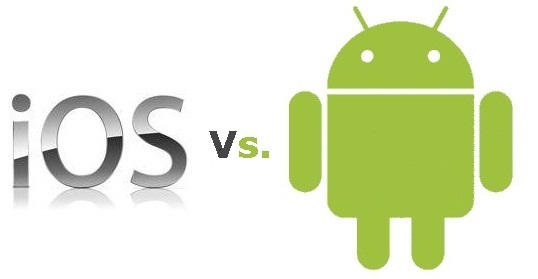
Over the years I’ve often gotten this question:
“Should I get my kid an Apple or Android phone?“
That can be an important decision, especially if you are concerned about security and parental controls.
So, let’s take a look at the features and differences between the Android and Apple iOS operating systems.
First off, after more than 20 years in this ministry I most STRONGLY advise parents that children Grade 6 and below do NOT need an individual phone. There are too many risks. I advise that parents get a basic “flip phone” (available at Best Buy, WalMart, Amazon.com, and other retailers) and let that be used only when needed. You may need more than one depending on how many kids you have an how active they are. Also, I recommend standards for chores and grades to be used to determine if they get a phone.
Android and iOS have won the “phone wars” over the past 15-20 years, with Microsoft, Nokia, and Blackberry no longer meaningful players in the field. In fact, while the Blackberry name continues to exist, it has moved on to the security software space.
In the early days (late 2000’s) there were lots of differences between smart phones. Those days have passed, with overall operation of cell phones share many common feature sets. So, I want to look at features and differences that are of interest for parents wanting to keep their children safer online and with technology.
Before we start here is some background on the two systems:
- Android is an “open” system based upon LINUX and other open-source software. That means that the code for all of Android is available. Different versions used to be referred to by “candy names” (Jelly Bean, Kit Kat, etc.) but are now referred to by version numbers. You can read more at this link: Android Version History
One real downside of Android is that Google releases it to the individual cell phone manufacturers and they “customize” it to suit their hardware and brand desires. Also, each manufacturer determines how many version upgrades they will allow a cell phone model to receive. Some only allow 3 upgrades while others offer 5. Beginning with the PIXEL 8, Google offers at least 7 years of system upgrades and 7 years of security updates. - Apple iOS is a closed, tightly controlled system based upon Apple’s desktop operating system: OS X. Versions are referred to solely by numbers. A few years ago Apple split their operating systems by hardware:
iOs for iPhones
iPadOS for iPads
macOS for desktop and laptop computers
WatchOS for Apple watches
tvOS for AppleTV devices
visionOS for the new Apple Vision Pro virtual reality system.
You can read more about the various Apple OS versions here: List of Apple Operating Systems.
Typically, Apple offers 5-6 upgrades on iPhones and iPads. Computers and Apple TV units typically can receive upgrades until their hardware is no longer capable of running a new version.
Security
The Systems
The Apple iOS system is often considered far more secure than Android due to designed in security and due to Apple having a tight hold on it’s proprietary OS. Its “ecosystem” (apps, interoperability with other hardware, etc.) is a “closed” system. One of the biggest differences between Apple and Android is that, in iOS, every app runs in it’s own “sandbox”. A sandbox is a set of tight controls that limit an apps ability to access other apps, hardware, network resources, user information, etc. Think of this as if iOS was running each app in it’s own little computer. This prevents many of the hacking and virus vulnerabilities that plague computers and non-Apple devices. It is not 100%, but it is a VERY tight system. In fact, parts of the iOS are not shared, even with app developers. Since they can’t access certain parts of iOS, they can’t access, or even discover, vulnerabilities that might arise.
Apple devices are also only manufactured by Apple. It controls the hardware and iOS operating system, ensuring the maximum compatibility and reducing issues.
Google delivers the base Android operating system to the manufacturers. They then tweak Android to work best with their particular phones and software,
The Android OS has a level of sandboxing but not nearly to the degree that Apple does. While this allows for some apps to have more features on Android than Apple, it is also provides far more opportunities for hackers and other bad guys!
The Stores
Another security feature that puts iOS ahead of Android is the Apple App Store. Apple maintains a stranglehold on the store, not allowing apps to be offered until they are completely vetted for content, malware/viruses, etc.. Apple, historically, has not allowed you to install apps except by going through their store (with some small exceptions), Recent regulations and legal decisions in the European Union are changing this.
The Google Play Store is more secure than it has been, but Android has the feature of being able to install apps from 3rd parties, bypassing the Play Store. This not only degrades security but it also bypasses any attempts to control apps, such as limiting hardcore pornography, etc. In 2012 Google increased security in the Play Store, but there remains the 3rd party workaround.
Updates
A final security issue is that most Apple devices are updated to the most recent OS fairly quickly and iOS updates are normally compatible with older equipment. For example, iOS 26, released in the Fall of 2025, is will be compatible with the iPhone 11 and newer, and the 2nd and 3rd generations of iPhone SE. Already, less than 8 weeks after release, iOS 26 has nearly 30% shares of iPhones. (Telemetrydeck) Apple also provides security updates long after a iPhone can no longer receive version upgrades. For instance, my OLD iPhone 7 still gets minor security updates after 10 years.
Android updates are a bit different and more complex a problem. As mentioned before, each phone manufacturer has to develop and release updates when needed, unlike Apple’s centrally managed OS. That means a phone or tablet manufacturer usually only provides updates for the latest devices and maybe the last 2-3 models, leaving older devices without needed security updates. To get the latest version of Android you often need to get a new phone.
Even though Android 16.0 has been out for over 9 months you can still buy brand new devices running Android 11.0. Newly bought iPhones, in contrast, will automatically check for the latest released version (17.6.1 in Aug 2024) and will prompt you to upgrade. iOS 26 is released although updates are public and developer beta testing.
NATIVE PARENTAL CONTROLS
APPLE
iOS has long offered built-in parental controls with their SCREEN TIME app in the form of RESTRICTIONS. These are available right out of the box, allowing you to set them up before giving the iPhone to a child. These restrictions enable parents to turn off app installation/deletion, set up web filters (that even filter the web when using cell data), and even set a max volume on the phone so the kids can’t blow their eardrums out.
These can be accessed through SETTINGS >> GENERAL>>RESTRICTIONS and require you to set a PASSCODE. DO NOT FORGET THIS CODE!
By the way, the passcode is only 4 digits, just like screenlock used to have. Screenlock expanded to 6 digits because parents found out that kids could start with 0000 and keep going up by 1 until they either unlocked the iPhone or hit 9999.
So, what about the RESTRICTIONS code? Well, after the 6th bad code, it locks you out for 1 minute. After the 7th: 5 minutes. And it keeps increasing. I’ve actually worked my phone up to a 3-day delay!
In addition to these controls Apple has implemented FAMILY SHARING for children under 13. This provides additional controls and allows the family to share apps, music, and videos.
Apple’s Family Sharing allows you to control your child’s iphone/ipad remotely from your own phone.
ANDROID
In recent years Google has increased the parental controls for Android devices. There are three parts of Google parental control system:
- USER Profiles
- Google Play Store Controls
- FamilyLink
User Profiles enable parents to create a separate account on their Android device for children to use. They can restrict what apps are available as well as set up SCREENTIME to allow the parent to control and monitor the child’s profile, even remotely.
The Play Store controls enable you to restrict the purchase of apps and media by age. It uses a 4-digit pin code to authorize it.
FamilyLink enables parents to set up controls for children. It is available for both Android and Apple devices.
IN SUMMARY
Apple and Android are both good systems. Due to the native parental controls and higher level of security I recommend iOS devices (iPhones and iPads) for children under 16. At age 16, while the child is still at home and under parental supervision, I recommend letting the child decide which phone system to use. This way parents can discuss the impacts and risks of various features, teaching the child to make wise decisions before leaving home.
